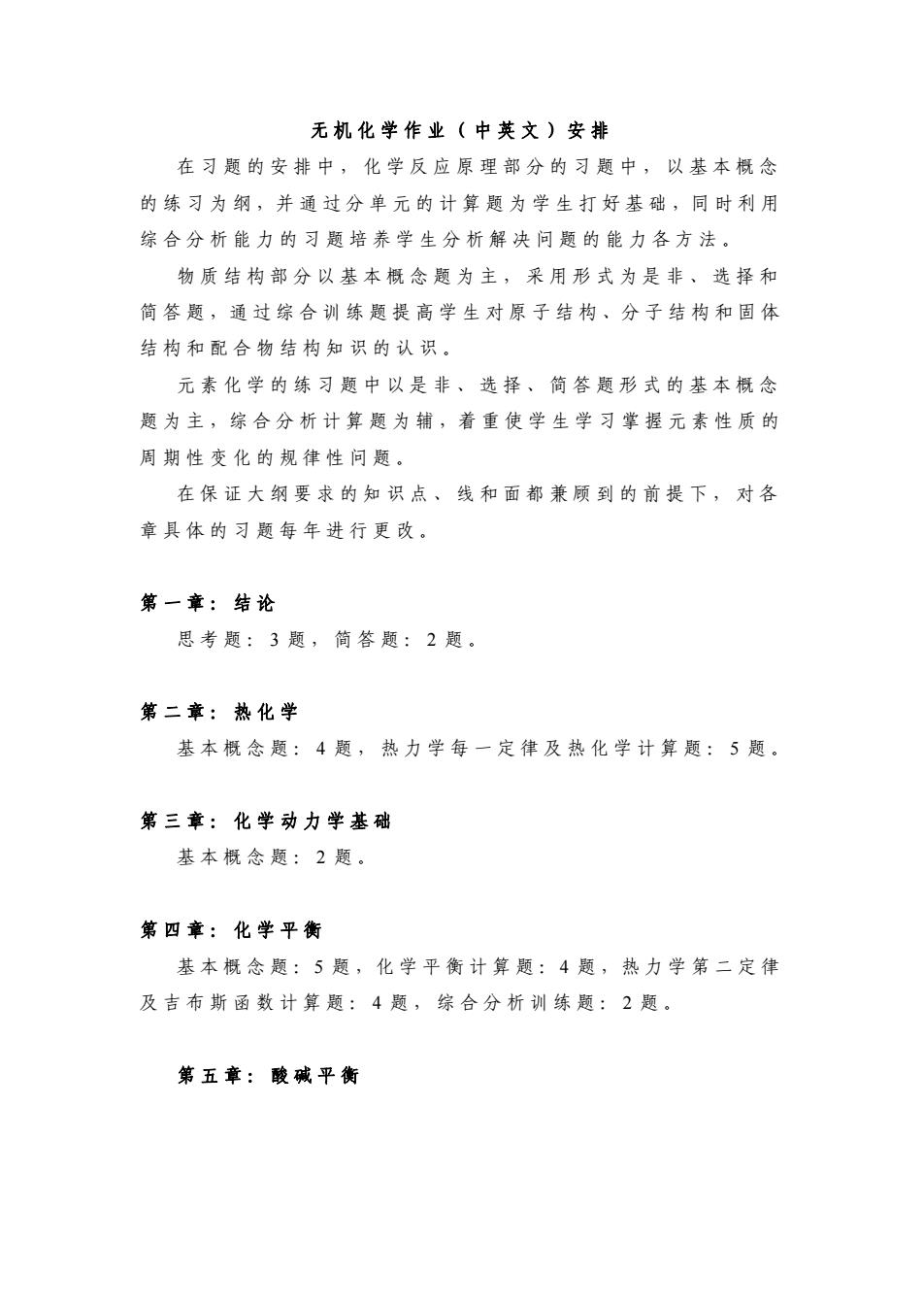
无机化学作业(中英文)安排 在习题的安排中,化学反应原理部分的习题中,以基本概念 的练习为纲,并通过分单元的计算题为学生打好基础,同时利用 综合分析能力的习题培养学生分析解决问题的能力各方法 物质结构部分以基本概念题为主,采用形式为是非、选择和 简答题,通过综合训练题提高学生对原子结构、分子结构和固体 结构和配合物结构知识的认识。 元素化学的练习题中以是非、选择、简答题形式的基本概念 题为主,综合分析计算题为辅,着重使学生学习掌握元素性质的 周期性变化的规律性问题。 在保证大纲要求的知识点、线和面都兼顾到的前提下,对各 章具体的习题每年进行更改。 第一章:结论 思考题:3题,简答题:2题。 第二章:热化学 基本概念题:4题,热力学每一定律及热化学计算题:5题。 第三章:化学动力学基础 基本概念题:2题。 第四章:化学平衡 基本概念题:5题,化学平衡计算题:4题,热力学第二定律 及吉布斯函数计算题:4题,综合分析训练题:2题。 第五章:酸碱平衡
无机化学作业(中英文)安排 在习题的安排中,化学反应原理部分的习题中,以基本概念 的 练 习 为 纲 ,并 通 过 分 单 元 的 计 算 题 为 学 生 打 好 基 础 ,同 时 利 用 综合分析能力的习题培养学生分析解决问题的能力各方法。 物质结构部分以基本概念题为主,采用形式为是非、选择和 简 答 题 ,通 过 综 合 训 练 题 提 高 学 生 对 原 子 结 构 、分 子 结 构 和 固 体 结构和配合物结构知识的认识。 元素化学的练习题中以是非、选择、简答题形式的基本概念 题 为 主 ,综 合 分 析 计 算 题 为 辅 ,着 重 使 学 生 学 习 掌 握 元 素 性 质 的 周期性变化的规律性问题。 在保证大纲要求的知识点、线和面都兼顾到的前提下,对各 章具体的习题每年进行更改。 第一章:结论 思考题: 3 题,简答题: 2 题 。 第二章:热化学 基本概念题: 4 题,热力学每一定律及热化学计算题: 5 题 。 第三章:化学动力学基础 基本概念题: 2 题 。 第四章:化学平衡 基本概念题:5 题,化学平衡计算题:4 题,热力学第二定律 及吉布斯函数计算题: 4 题,综合分析训练题: 2 题 。 第五章:酸碱平衡
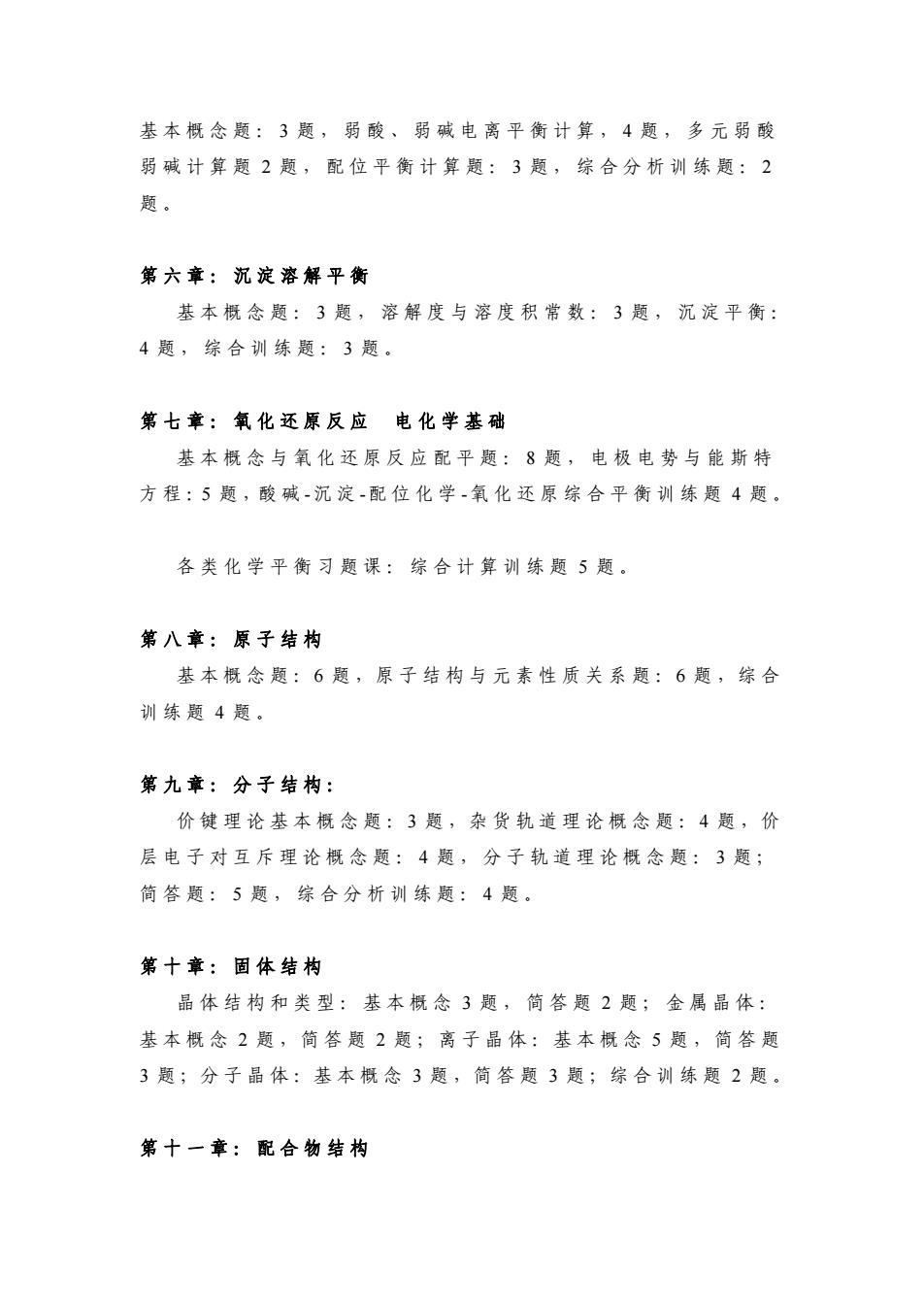
基本概念题:3题,弱酸、弱碱电离平衡计算,4题,多元弱酸 弱碱计算题2题,配位平衡计算题:3题,综合分析训练题:2 题 第六章:沉淀溶解平衡 基本概念题:3题,溶解度与溶度积常数:3题,沉淀平衡: 4题,综合训练题:3题。 第七章:氧化还原反应电化学基础 基本概念与氧化还原反应配平题:8题,电极电势与能斯特 方程:5题,酸碱-沉淀-配位化学.氧化还原综合平衡训练题4题 各类化学平衡习题课:综合计算训练题5题。 第八章:原子结构 基本概念题:6题,原子结构与元素性质关系题:6题,综合 训练题4题。 第九章:分子结构: 价键理论基本概念题:3题,杂货轨道理论概念题:4题,价 层电子对互斥理论概念题:4题,分子轨道理论概念题:3题; 简答题:5题,综合分析训练题:4题。 第十章:固体结构 晶体结构和类型:基本概念3题,简答题2题;金属晶体: 基本概念2题,简答题2题;离子晶体:基本概念5题,简答题 3题;分子晶体:基本概念3题,简答题3题;综合训练题2通。 第十一章:配合物结构
基本概念题: 3 题,弱酸、弱碱电离平衡计算, 4 题,多元弱酸 弱碱计算题 2 题,配位平衡计算题: 3 题,综合分析训练题: 2 题 。 第六章:沉淀溶解平衡 基本概念题: 3 题,溶解度与溶度积常数: 3 题,沉淀平衡: 4 题,综合训练题: 3 题 。 第七章:氧化还原反应 电化学基础 基本概念与氧化还原反应配平题: 8 题,电极电势与能斯特 方程:5 题 ,酸 碱 -沉 淀 -配位化学 -氧化还原综合平衡训练题 4 题 。 各类化学平衡习题课:综合计算训练题 5 题 。 第八章:原子结构 基本概念题:6 题,原子结构与元素性质关系题:6 题,综合 训练题 4 题 。 第九章:分子结构: 价键理论基本概念题:3 题,杂货轨道理论概念题:4 题,价 层电子对互斥理论概念题: 4 题,分子轨道理论概念题: 3 题 ; 简答题: 5 题,综合分析训练题: 4 题 。 第十章:固体结构 晶体结构和类型:基本概念 3 题,简答题 2 题;金属晶体: 基本概念 2 题,简答题 2 题;离子晶体:基本概念 5 题,简答题 3 题 ;分 子 晶 体 :基 本 概 念 3 题 ,简 答 题 3 题 ;综 合 训 练 题 2 题 。 第十一章:配合物结构
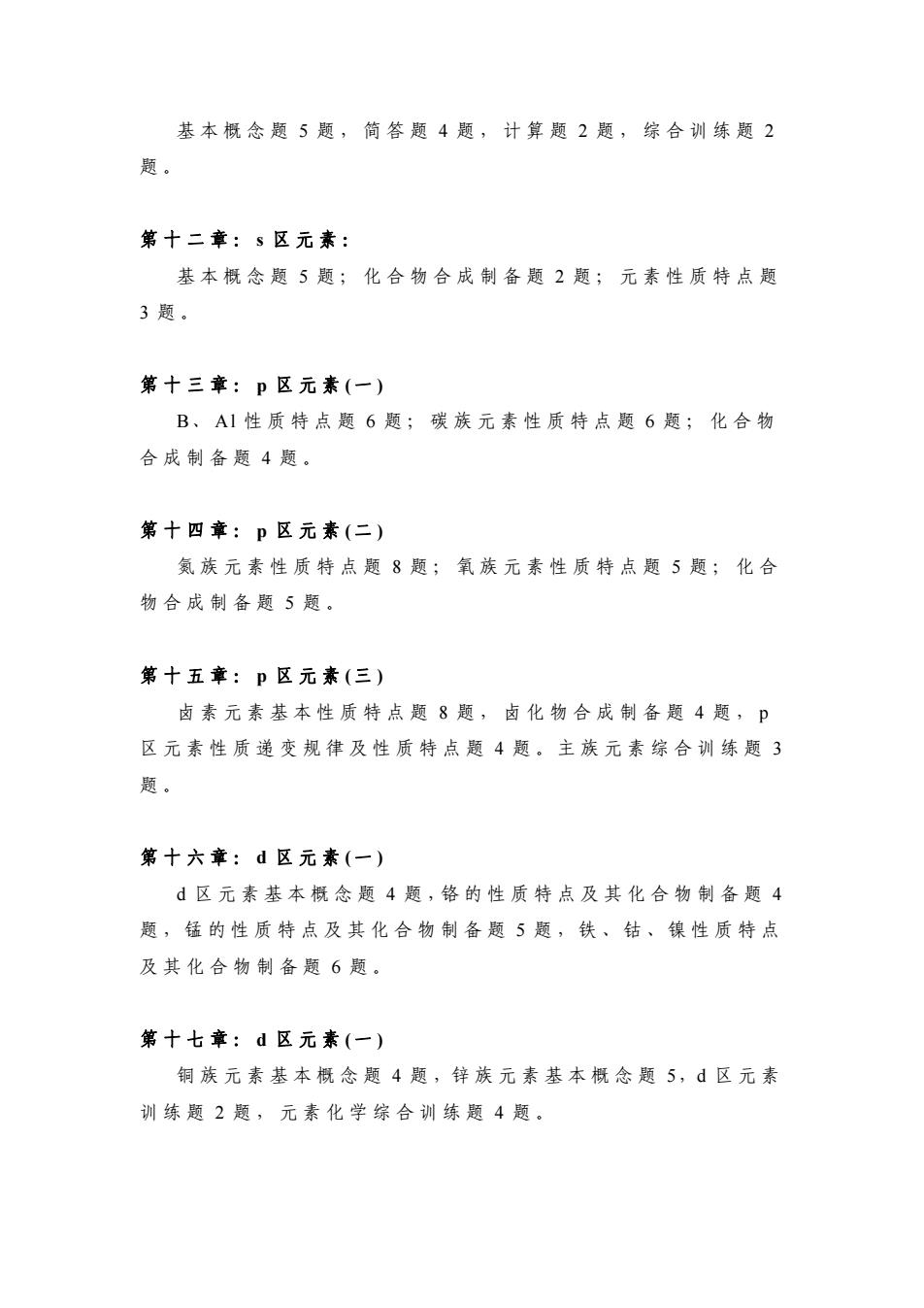
基本概念题5题,简答题4题,计算题2题,综合训练题2 题。 第十二章:s区元素: 基本概念题5题;化合物合成制备题2题;元素性质特点题 3题。 第十三章:p区元素(一) B、A1性质特点题6题;碳族元素性质特点题6题;化合物 合成制备题4题。 第十四章:p区元素(二) 氮族元素性质特点题8题;氧族元素性质特点题5题;化合 物合成制备题5题。 第十五章:p区元素(三) 卤素元素基本性质特点题8题,卤化物合成制备题4题,P 区元素性质递变规律及性质特点题4题,主族元素综合训练题3 题。 第十六章:d区元素(一) 区元素基本概念题4题,铬的性质特点及其化合物制备题4 题,锰的性质特点及其化合物制备题5题,铁、钴、镍性质特点 及其化合物制备题6题。 第十七章:d区元素(一) 铜族元素基本概念题4题,锌族元素基本概念题5,d区元素 训练题2题,元素化学综合训练题4题
基本概念题 5 题,简答题 4 题,计算题 2 题,综合训练题 2 题 。 第十二章: s 区元素: 基本概念题 5 题;化合物合成制备题 2 题;元素性质特点题 3 题 。 第十三章: p 区元素 (一 ) B、 Al 性质特点题 6 题;碳族元素性质特点题 6 题;化合物 合成制备题 4 题 。 第十四章: p 区元素 (二 ) 氮族元素性质特点题 8 题;氧族元素性质特点题 5 题;化合 物合成制备题 5 题 。 第十五章: p 区元素 (三 ) 卤素元素基本性质特点题 8 题,卤化物合成制备题 4 题 , p 区元素性质递变规律及性质特点题 4 题。主族元素综合训练题 3 题 。 第十六章: d 区元素 (一 ) d 区元素基本概念题 4 题 ,铬 的 性 质 特 点 及 其 化 合 物 制 备 题 4 题,锰的性质特点及其化合物制备题 5 题,铁、钴、镍性质特点 及其化合物制备题 6 题 。 第十七章: d 区元素 (一 ) 铜族元素基本概念题 4 题 ,锌 族 元 素 基 本 概 念 题 5,d 区元素 训练题 2 题,元素化学综合训练题 4 题
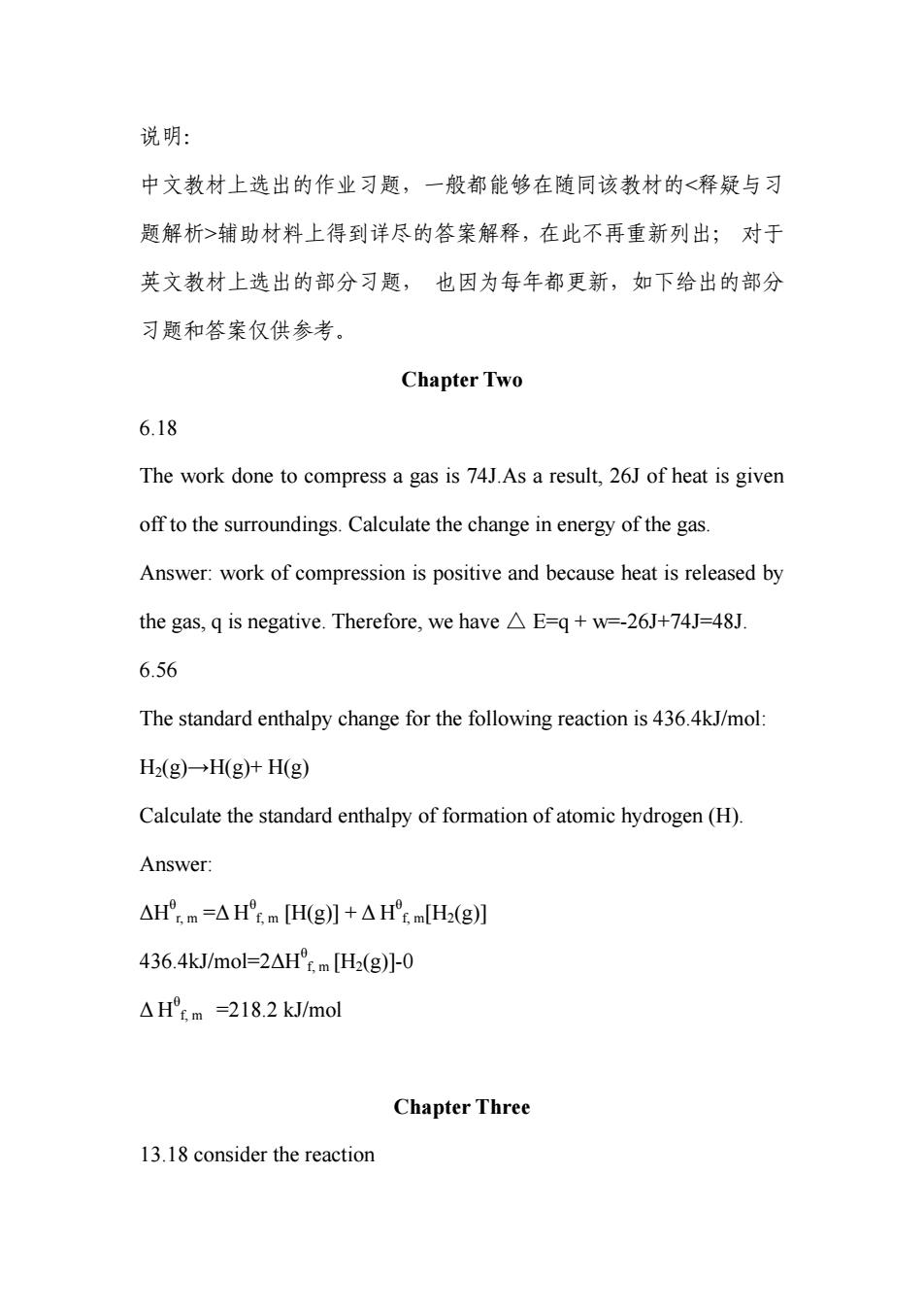
说明: 中文教材上选出的作业习题,一般都能够在随同该教材的辅助材料上得到详尽的答案解释,在此不再重新列出;对于 英文教材上选出的部分习题,也因为每年都更新,如下给出的部分 习题和答案仅供参考。 Chapter Two 6.18 The work done to compress a gas is 74J.As a result,26J of heat is given off to the surroundings.Calculate the change in energy of the gas Answer:work of compression is positive and because heat is released by the gas,q is negative.Therefore,we have A E=q+w=-26J+74J=48J. 6.56 The standard enthalpy change for the following reaction is 436.4kJ/mol: H(g)→H(g+H(g) Calculate the standard enthalpy of formation of atomic hydrogen(H) Answer: △HEm=△HmH(g】+△HmH(g] 436.4kJ/mol=2AH.m [H2(g)]-0 △Hem=218.2kJ/mol Chapter Three 13.18 consider the reaction
说明: 中文教材上选出的作业习题,一般都能够在随同该教材的辅助材料上得到详尽的答案解释,在此不再重新列出; 对于 英文教材上选出的部分习题, 也因为每年都更新,如下给出的部分 习题和答案仅供参考。 Chapter Two 6.18 The work done to compress a gas is 74J.As a result, 26J of heat is given off to the surroundings. Calculate the change in energy of the gas. Answer: work of compression is positive and because heat is released by the gas, q is negative. Therefore, we have △ E=q + w=-26J+74J=48J. 6.56 The standard enthalpy change for the following reaction is 436.4kJ/mol: H2(g)→H(g)+ H(g) Calculate the standard enthalpy of formation of atomic hydrogen (H). Answer: ΔHθ r, m =Δ Hθ f, m [H(g)] + Δ Hθ f, m[H2(g)] 436.4kJ/mol=2ΔHθ f, m [H2(g)]-0 Δ Hθ f, m =218.2 kJ/mol Chapter Three 13.18 consider the reaction
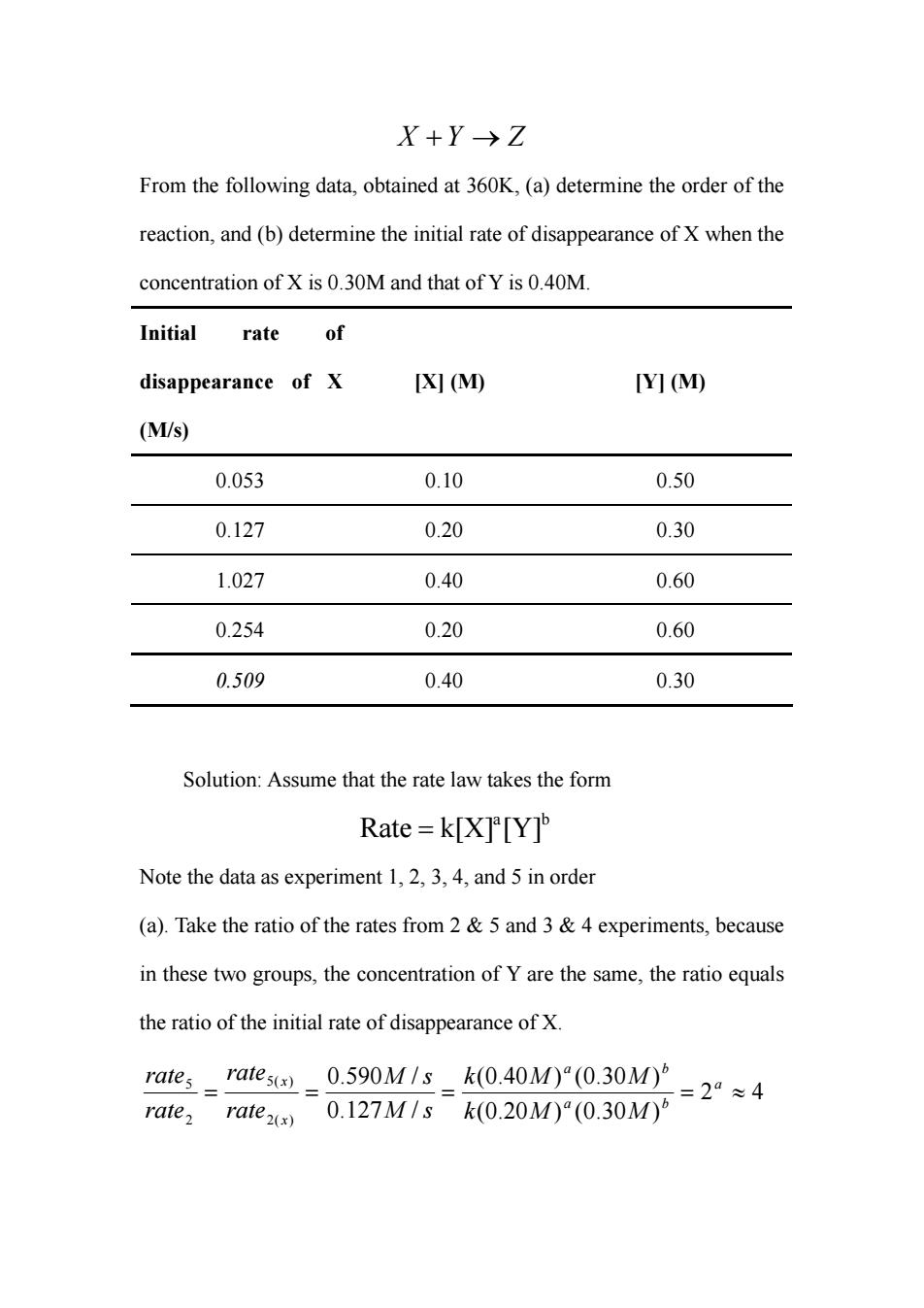
X+Y→Z From the following data,obtained at 360K,(a)determine the order of the reaction,and(b)determine the initial rate of disappearance of X when the concentration of X is 0.30M and that of Y is 0.40M. Initial rate of disappearance of X [X](M) [Y](M) (M/s) 0.053 0.10 0.50 0.127 0.20 0.30 1.027 0.40 0.60 0.254 0.20 0.60 0.509 0.40 0.30 Solution:Assume that the rate law takes the form Rate=k[XT[Y] Note the data as experiment 1,2,3,4,and 5 in order (a).Take the ratio of the rates from 2&5 and 3&4 experiments,because in these two groups,the concentration of Y are the same,the ratio equals the ratio of the initial rate of disappearance of X. rate3=ae-0.590M/s_k0.40M0°(0.30M rate,rate2x) =20≈4 0.127M1sk0.20M)°(0.30M)
+ → ZYX From the following data, obtained at 360K, (a) determine the order of the reaction, and (b) determine the initial rate of disappearance of X when the concentration of X is 0.30M and that of Y is 0.40M. Initial rate of disappearance of X (M/s) [X] (M) [Y] (M) 0.053 0.10 0.50 0.127 0.20 0.30 1.027 0.40 0.60 0.254 0.20 0.60 0.509 0.40 0.30 Solution: Assume that the rate law takes the form ba = [Y]k[X]Rate Note the data as experiment 1, 2, 3, 4, and 5 in order (a). Take the ratio of the rates from 2 & 5 and 3 & 4 experiments, because in these two groups, the concentration of Y are the same, the ratio equals the ratio of the initial rate of disappearance of X. 42 )30.0()20.0( )30.0()40.0( /127.0 /590.0 )(2 )(5 2 5 == = ≈= a a b a b x x MMk MMk sM sM rate rate rate rate
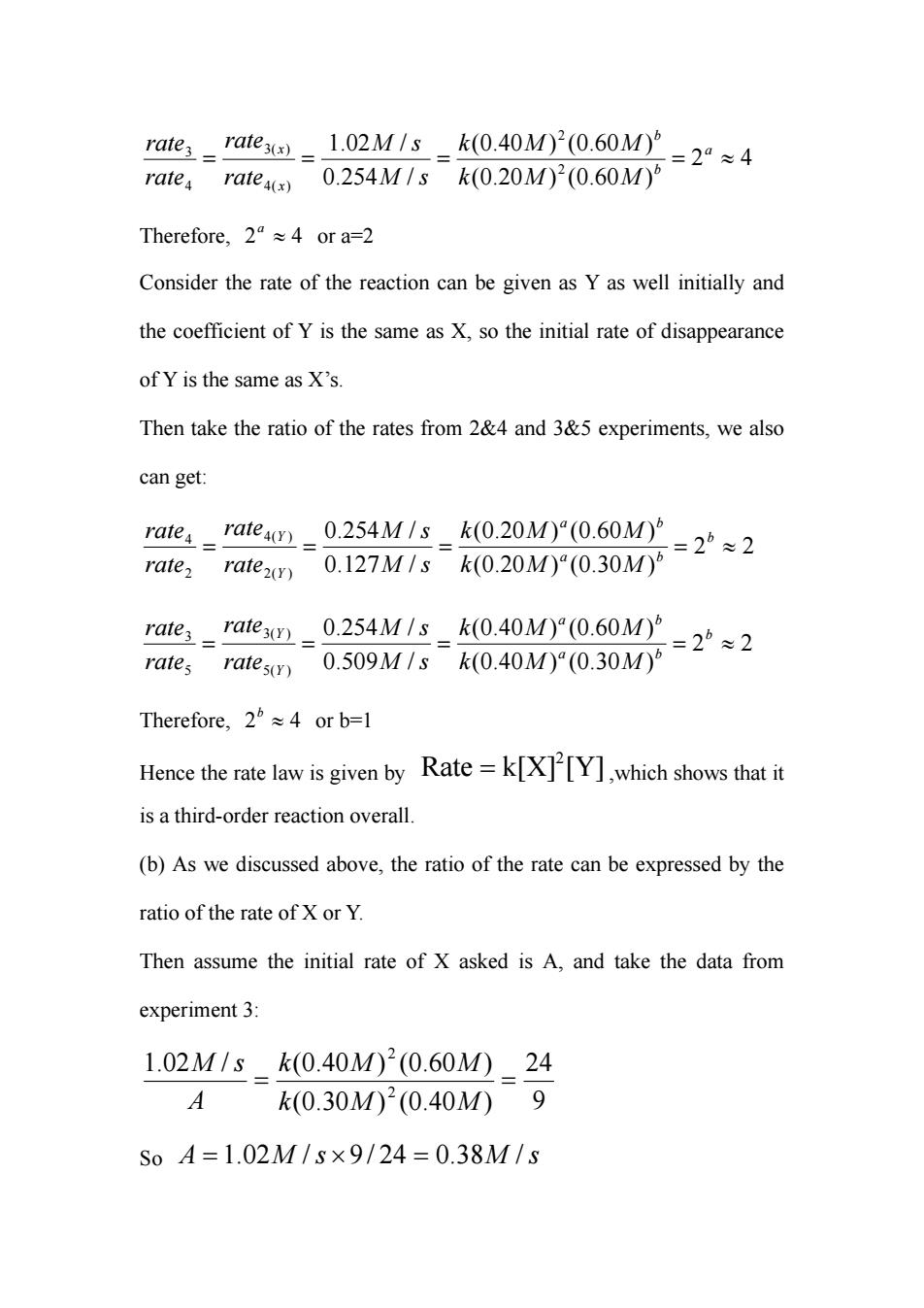
rae3-ae3=1.02M/s-k(0.40M)2(0.60M =24≈4 rate,rate()0.254M/s k(0.20M)2(0.60M) Therefore,2a≈4ora=2 Consider the rate of the reaction can be given as Y as well initially and the coefficient of Y is the same as X,so the initial rate of disappearance of Y is the same as X's. Then take the ratio of the rates from 2&4 and 3&5 experiments,we also can get: rate=ae4n=0.254M/s-k(0.20M)°(0.60M0 =26≈2 ratez ratez)0.127M/s k(0.20M)(0.30M) ae=aem=0.254M/s_k0.40MP(0.60M rae,rates0.509M1sk(0.40M°(0.30M0° =2”≈2 Therefore,.2≈4orb-l Hence the rate law is given by Rate=k[X[Y],which shows that it is a third-order reaction overall. (b)As we discussed above,the ratio of the rate can be expressed by the ratio of the rate of X or Y. Then assume the initial rate of X asked is A,and take the data from experiment 3: 1.02M/sk(0.40M)2(0.60M)24 A k(0.30M02(0.40M)9 S0A=1.02M/s×9/24=0.38M/s
42 )60.0()20.0( )60.0()40.0( /254.0 /02.1 2 2 )(4 )(3 4 3 == = ≈= a b b x x MMk MMk sM sM rate rate rate rate ≈ 42a Therefore, or a=2 Consider the rate of the reaction can be given as Y as well initially and the coefficient of Y is the same as X, so the initial rate of disappearance of Y is the same as X’s. Then take the ratio of the rates from 2&4 and 3&5 experiments, we also can get: 22 )30.0()20.0( )60.0()20.0( /127.0 /254.0 )(2 )(4 2 4 == = ≈= b a b a b Y Y MMk MMk sM sM rate rate rate rate 22 )30.0()40.0( )60.0()40.0( /509.0 /254.0 )(5 )(3 5 3 == = ≈= b a b a b Y Y MMk MMk sM sM rate rate rate rate ≈ 42b Therefore, or b=1 Hence the rate law is given by ,which shows that it is a third-order reaction overall. [Y]k[X]Rate 2 = (b) As we discussed above, the ratio of the rate can be expressed by the ratio of the rate of X or Y. Then assume the initial rate of X asked is A, and take the data from experiment 3: 9 24 )40.0()30.0( )60.0()40.0(/02.1 2 2 = = MMk MMk A sM So = sMA × = /38.024/9/02.1 sM
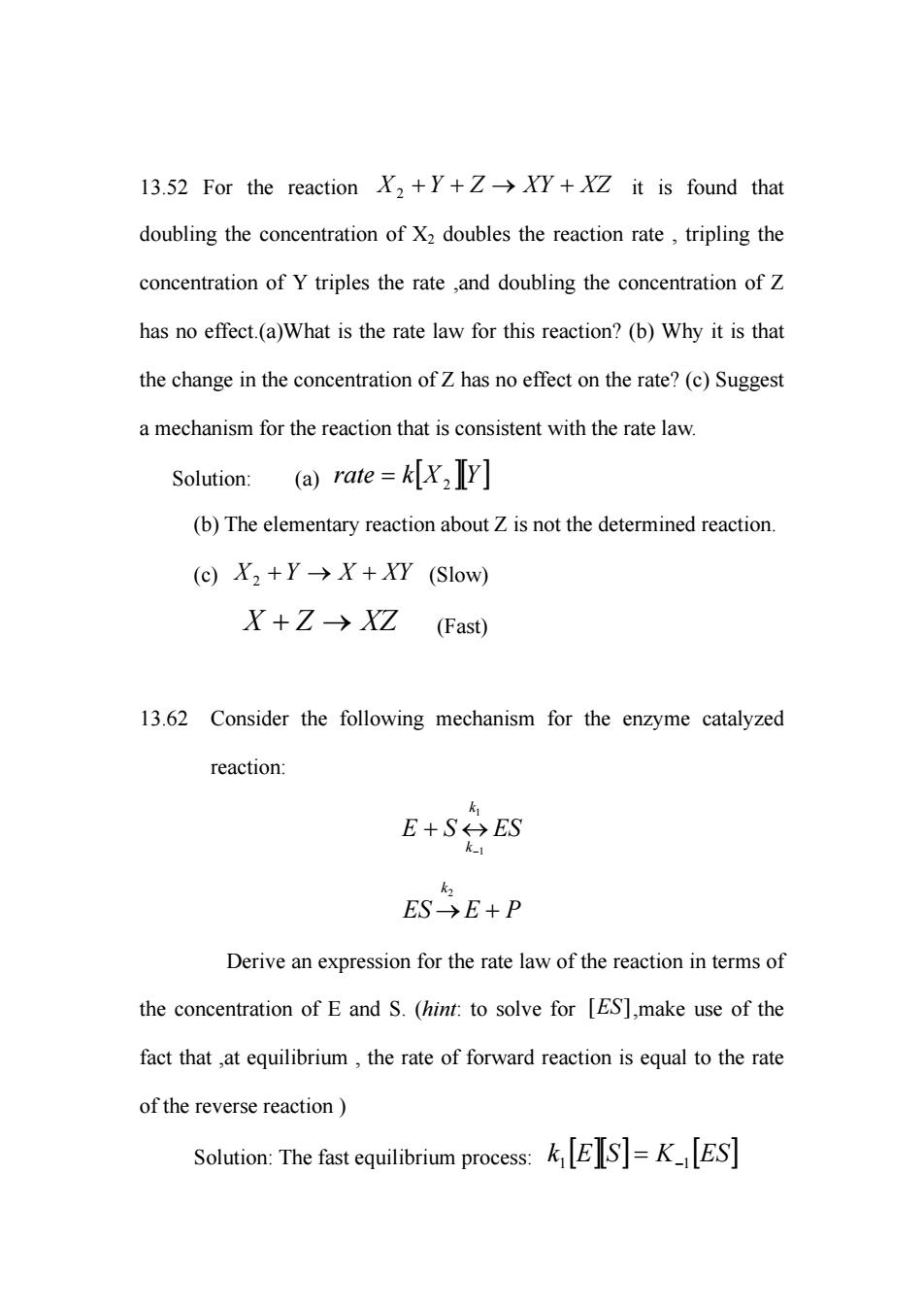
13.52 For the reaction2++Z+it is found that doubling the concentration of X2 doubles the reaction rate,tripling the concentration of Y triples the rate ,and doubling the concentration of Z has no effect.(a)What is the rate law for this reaction?(b)Why it is that the change in the concentration ofZ has no effect on the rate?(c)Suggest a mechanism for the reaction that is consistent with the rate law Solution:(a)rate=k[X2IY] (b)The elementary reaction about Z is not the determined reaction. (c)X2+Y>X+XY (Slow) X+Z→XZ(Fast) 13.62 Consider the following mechanism for the enzyme catalyzed reaction: E+S分ES ES>E+P Derive an expression for the rate law of the reaction in terms of the concentration of E and S.(hint:to solve for [ES],make use of the fact that,at equilibrium,the rate of forward reaction is equal to the rate of the reverse reaction) Solution:The fast equilibrium process:k]=KES]
13.52 For the reaction 2 + + → + XZXYZYX it is found that doubling the concentration of X2 doubles the reaction rate , tripling the concentration of Y triples the rate ,and doubling the concentration of Z has no effect.(a)What is the rate law for this reaction? (b) Why it is that the change in the concentration of Z has no effect on the rate? (c) Suggest a mechanism for the reaction that is consistent with the rate law. [ ][YXkrate ] Solution: (a) = 2 (b) The elementary reaction about Z is not the determined reaction. (c) +→+ XYXYX (Slow) 2 + → XZZX (Fast) 13.62 Consider the following mechanism for the enzyme catalyzed reaction: ESSE k k 1 −1 ↔+ PEES k +→ 2 Derive an expression for the rate law of the reaction in terms of the concentration of E and S. (hint: to solve for ,make use of the fact that ,at equilibrium , the rate of forward reaction is equal to the rate of the reverse reaction ) ES][ [ ][ ] [ESKSEk1 −1 Solution: The fast equilibrium process: = ]
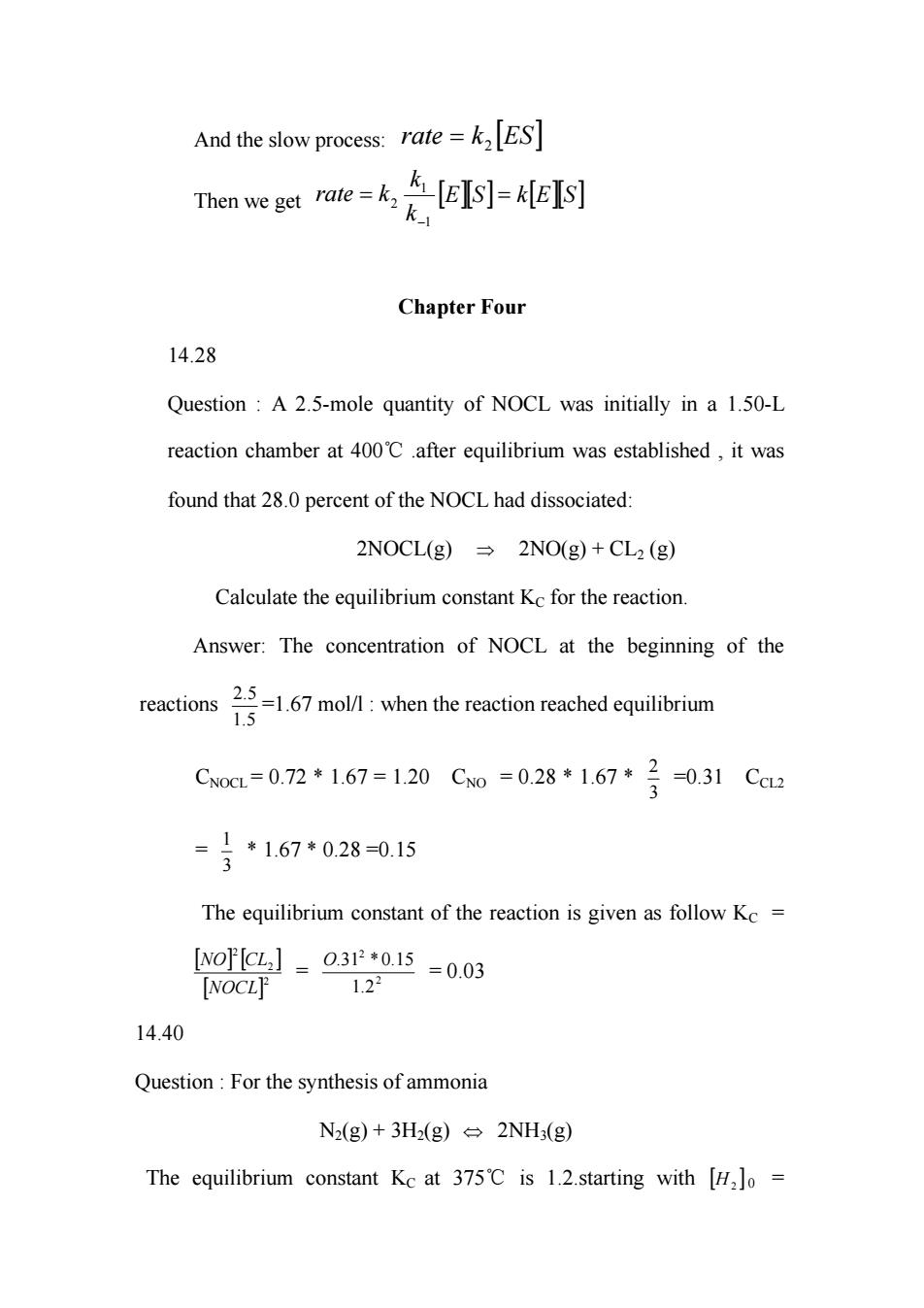
And the slow process:rate=kES] Then we get rale=k,车Gy-ke时 k Chapter Four 14.28 Question:A 2.5-mole quantity of NOCL was initially in a 1.50-L reaction chamber at 400C .after equilibrium was established,it was found that 28.0 percent of the NOCL had dissociated: 2NOCL(g)2NO(g)+CL2(g) Calculate the equilibrium constant Kc for the reaction. Answer:The concentration of NOCL at the beginning of the Cw0=0.72*167=120C0=028*1.67*号-031Cc =号167*028=0.15 The equilibrium constant of the reaction is given as follow Kc= [ojCl_032*015=0.03 NOCL 1.22 14.40 Question:For the synthesis of ammonia N2(g)+3Hg)=2NH3(g) The equilibrium constant Kc at 375C is 1.2.starting with [H]o=
[ESkrate ] And the slow process: = 2 [ ][ ] [ ][ ] SEkSE k k = krate = −1 1 Then we get 2 Chapter Four 14.28 Question : A 2.5-mole quantity of NOCL was initially in a 1.50-L reaction chamber at 400℃ .after equilibrium was established , it was found that 28.0 percent of the NOCL had dissociated: 2NOCL(g) ⇒ 2NO(g) + CL2 (g) Calculate the equilibrium constant KC for the reaction. Answer: The concentration of NOCL at the beginning of the reactions 5.1 5.2 =1.67 mol/l : when the reaction reached equilibrium 3 2 CNOCL = 0.72 * 1.67 = 1.20 CNO = 0.28 * 1.67 * =0.31 CCL2 3 1 = * 1.67 * 0.28 =0.15 The equilibrium constant of the reaction is given as follow KC = [ ][ [ ] ] 2 2 2 NOCL CLNO 2 2 2.1 O 15.0*31. = = 0.03 14.40 Question : For the synthesis of ammonia N2(g) + 3H2(g) ⇔ 2NH3(g) [H2 The equilibrium constant KC at 375 is 1.2.starting with ℃ ] 0 =
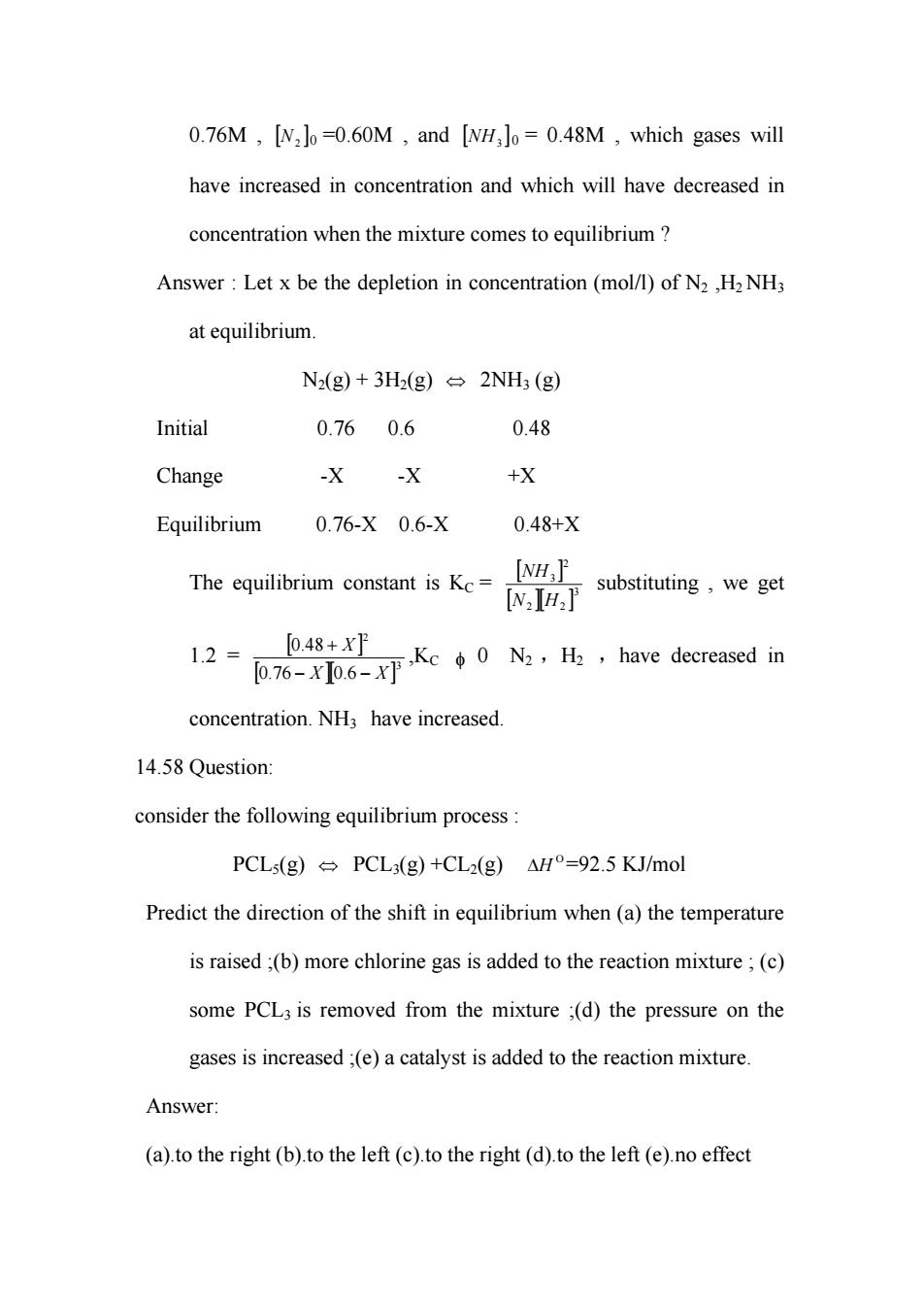
0.76M,[N2 ]o =0.60M and [NH;]o =0.48M,which gases will have increased in concentration and which will have decreased in concentration when the mixture comes to equilibrium Answer:Let x be the depletion in concentration(mol/l)of N2,H2 NH3 at equilibrium. N2(g)+3H2(g)a2NH3(g) Initial 0.760.6 0.48 Change -X-X +X Equilibrium 0.76-X 0.6-X 0.48+X [0.48+xF 12=D76P我p6-xTKc◆0N,,have dereasd in concentration.NH3 have increased. 14.58 Question: consider the following equilibrium process PCLs(g)÷PCL(g)+CL2(g)△H°=92.5 KJ/mol Predict the direction of the shift in equilibrium when(a)the temperature is raised;(b)more chlorine gas is added to the reaction mixture;(c) some PCL3 is removed from the mixture ;(d)the pressure on the gases is increased;(e)a catalyst is added to the reaction mixture. Answer: (a).to the right (b).to the left (c).to the right (d).to the left (e).no effect
=0.60M , and [ ] NH3 [ ] 0.76M , N2 0 0 = 0.48M , which gases will have increased in concentration and which will have decreased in concentration when the mixture comes to equilibrium ? Answer : Let x be the depletion in concentration (mol/l) of N2 ,H2 NH3 at equilibrium. N2(g) + 3H2(g) ⇔ 2NH3 (g) Initial 0.76 0.6 0.48 Change -X -X +X Equilibrium 0.76-X 0.6-X 0.48+X [ ] [ ][ ]3 22 2 3 HN NH The equilibrium constant is KC = substituting , we get 1.2 = [ ] [ ][ ] 3 2 6.076.0 48.0 XX X −− + ,KC φ 0 N2 ,H2 ,have decreased in concentration. NH3 have increased. 14.58 Question: consider the following equilibrium process : PCL5(g) ⇔ PCL3(g) +CL2(g) =92.5 KJ/mol Ο ΔH Predict the direction of the shift in equilibrium when (a) the temperature is raised ;(b) more chlorine gas is added to the reaction mixture ; (c) some PCL3 is removed from the mixture ;(d) the pressure on the gases is increased ;(e) a catalyst is added to the reaction mixture. Answer: (a).to the right (b).to the left (c).to the right (d).to the left (e).no effect
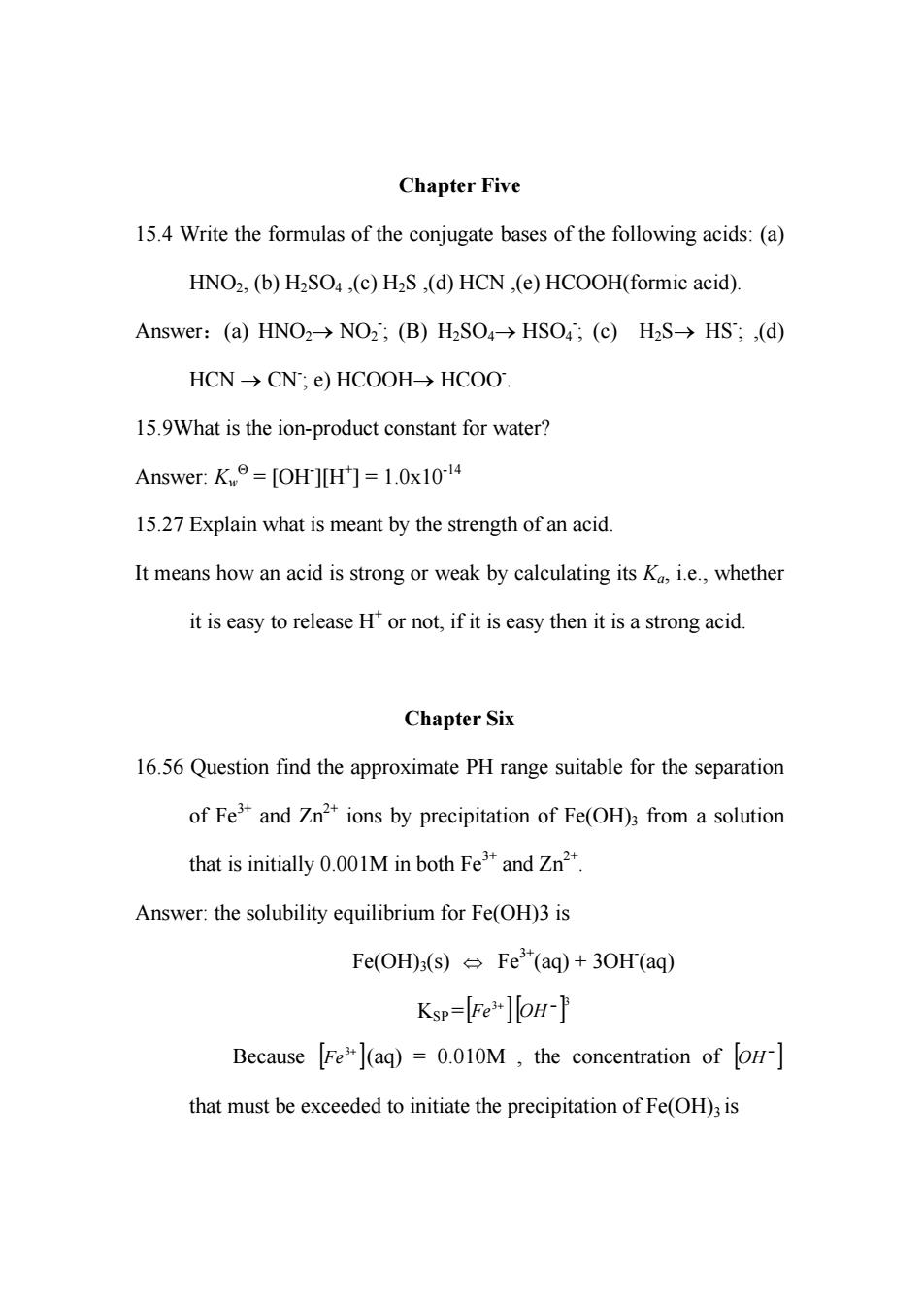
Chapter Five 15.4 Write the formulas of the conjugate bases of the following acids:(a) HNO2,(b)H2SO4,(c)H2S ,(d)HCN,(e)HCOOH(formic acid) Answer:(a)HNO2→NO2;(B)HSO4→HSO4;(c)HS→HS;,(d) HCN→CN,e)HCOOH→HCOO 15.9What is the ion-product constant for water? Answer:K=[OH][H']=1.0x1014 15.27 Explain what is meant by the strength of an acid. It means how an acid is strong or weak by calculating its K,i.e.,whether it is easy to release H'or not,if it is easy then it is a strong acid. Chapter Six 16.56 Question find the approximate PH range suitable for the separation of Fe and Zn2ions by precipitation of Fe(OH)3 from a solution that is initially 0.001M in both Feand Zn2 Answer:the solubility equilibrium for Fe(OH)3 is Fe(OH)3(s)Fe(aq)+30H(aq) Ksp=Fe]OH-P Because Fe"(aq)=0.010M,the concentration of OH that must be exceeded to initiate the precipitation of Fe(OH)3 is
Chapter Five 15.4 Write the formulas of the conjugate bases of the following acids: (a) HNO2, (b) H2SO4 ,(c) H2S ,(d) HCN ,(e) HCOOH(formic acid). Answer:(a) HNO2→ NO2 - ; (B) H2SO4→ HSO4 - - ; (c) H2S→ HS ; ,(d) HCN → CN- ; e) HCOOH→ HCOO- . 15.9What is the ion-product constant for water? - Answer: Kw Θ = [OH ][H+ ] = 1.0x10-14 15.27 Explain what is meant by the strength of an acid. It means how an acid is strong or weak by calculating its Ka, i.e., whether it is easy to release H+ or not, if it is easy then it is a strong acid. Chapter Six 16.56 Question find the approximate PH range suitable for the separation of Fe3+ 2+ and Zn ions by precipitation of Fe(OH)3 from a solution that is initially 0.001M in both Fe3+ 2+ and Zn . Answer: the solubility equilibrium for Fe(OH)3 is Fe(OH)3(s) ⇔ Fe3+ - (aq) + 3OH (aq) [ ] 3 − [ ] OH 3+ KSP = Fe [ ] 3+ Fe (aq) = 0.010M , the concentration of [ ] − Because OH that must be exceeded to initiate the precipitation of Fe(OH)3 is